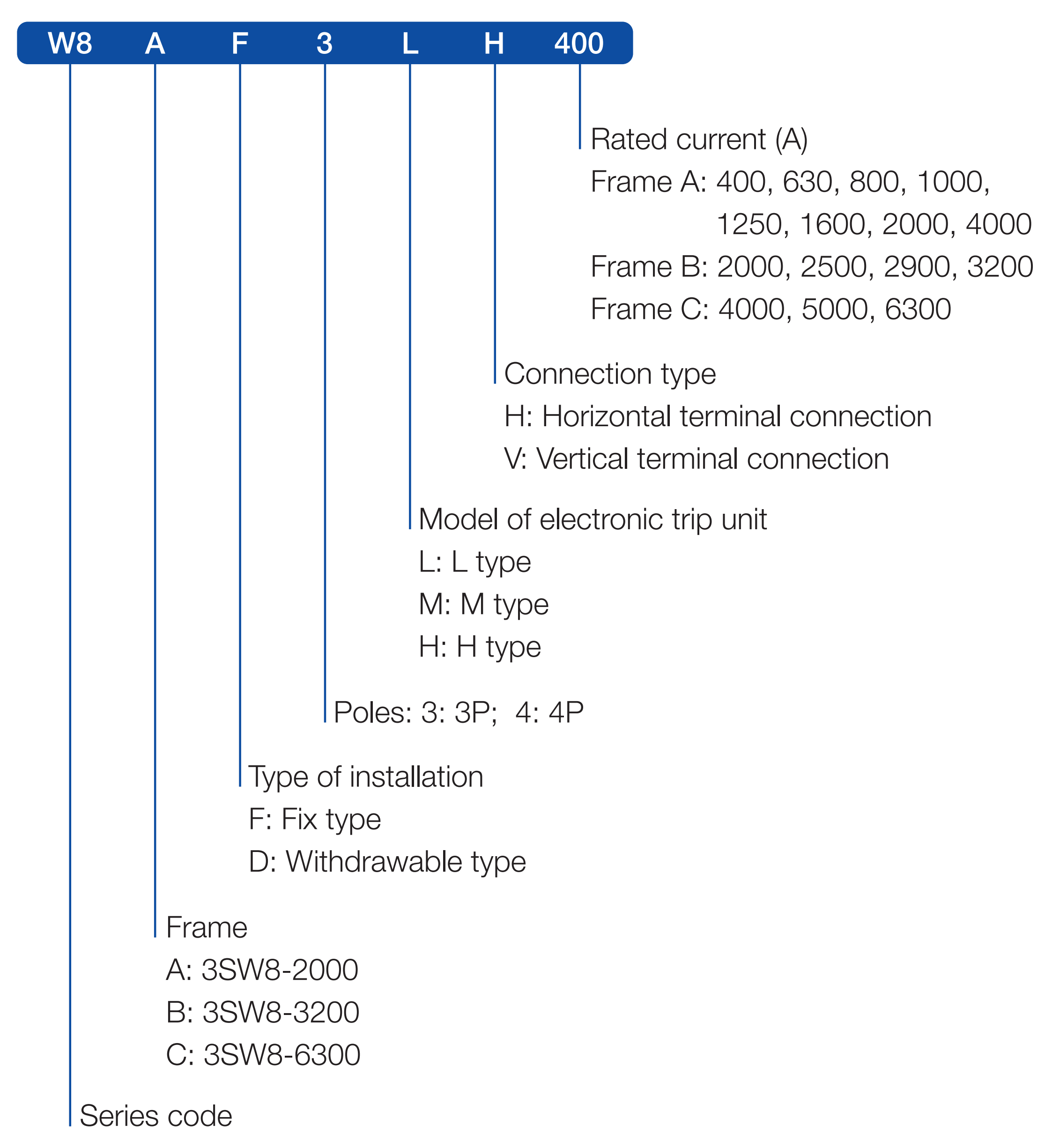
3SW8 series ACB has fixed type and withdrawable type. Putting the fixed breaker into the drawer base becomes drawer type circuit breaker. The breaker consists of contact system, arc extinction system, operation mechanism, electronic trip unit, auxiliary switch, secondary circuit wiring terminal, under voltage release, shunt release, closing coil, etc.
Applications And Functions
Incoming-feeder and outgoing-feeder function in distribution systems
Switching and protecting large powers, motors, capacitors,generators, transformers, busbars and cables
Overload protection
Short-time delayed short-circuit protection
Instantaneous short-circuit protection used in buildings, industries, energy and infrastructures
Technical specifications

Instruction of type

Normal Operation and Installation Conditions
Ambient temperature: -5°C ~ +40 °C, and the average temperature does not exceed +35 °C within 24 h.
Altitude: Not higher than 2000 m. The capacity should be decreased if the altitude is above 2000 m.
Humidity: When the ambient air temperature is +40 °C, the relative humidity of the air shall not be higher than 50%, a higher relative humidity is allowed at a lower temperature. For example, the relative humidity should be 90% when temperature is 20 °C. Special measures should be adopted for the condensation occasionally produced due to change of temperature.
Pollution degree: 3.
The circuit breaker can be used in electromagnetic environment A.
Installing category: IV for main circuit; III for other auxiliary and control circuits.
The vertical gradient: no more than 5°.
Mounting Ambient: There must be no explosive medium, no gas which would corrode metal or any conducting dust which would destroy the insulation.
The circuit breakers should be installed in the compartment of switchgear cabinet with doorframes fixed additionally. Protection grade is up to IP40.
Installation
Check the following items before installation:
Check the label plate on the breaker panel to see if it fits the specifications of the ordered goods rated current;
Voltage and time delay of under voltage release;
Voltage of shunt release;
Voltage of closing coil;
Voltage of motorized operating mechanism.
Before installation, operation, maintenance and inspection, you shall read this manual, and consult the manufacturer for questions if any.
Preparations before installation:
Before the breaker is installed, check the insulation resistance of the breaker by using a 1000V megohmmeter according to regulations; when the surrounding media temperature is 25 °C ± 5 °C and the relative humidity is 5% ~ 70%, the insulation resistance shall not be less than 20 megohm.
The place with the insulation resistance to be tested includes: the place between various phases and between various phases and the frame when the breaker is closed; the place between in-and out-lines of various phases when the breaker is switched off.
Installation of the fixed type breaker:
Place the breaker into the distribution cabinet, and fasten it by using 4 pieces of M6 (Inm=1600 A) or M10 (Inm=3200 A or above) bolts and washers; the breaker shall be installed stably with no d=additional mechanical stress to avoid damage of the breaker or bad contact of the main busbar and the secondary circuit. After the work is completed, mount the body into the draw-out socket.
The specification of the wiring copper bars for the primary circuit of the breaker shall meet the copper bar specification used under the conditions of conventional heating in IEC 60947-2.
The breaker shall be grounded substantially.